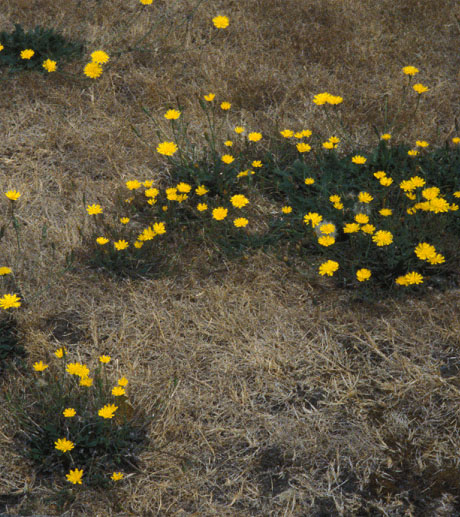
|
| Cat's-Ear; Hypochæris
radicata L. |
Sunflower Family; COMPOSITÆ (ASTERACEÆ)
|
| Cat's-Ear is a strongly taprooted perennial herb, evergreen, very abundant and a Dandelion relative. It flourishes in poor
lawns, meadows, vacant lots, roadsides, sandy waste places: any average sunny site, no matter how dry. It hates shade. |
| Lying flat against the ground, its fuzzy "Cat's-Ear" leaves spread a broad wavy circle around the root. From their midst arise
branched, wiry, skinny stems bearing many inch-wide dandelion-like flowers. The topmost tips of these branched flowerstems are usually
11/2 to
21/2 feet tall, with the very strongest specimens in suitable conditions surpassing five feet in height. Puffball seed-heads succeed the
spent blossoms. The chief bloom period is May and June,
after the peak for Dandelions. Flowers can be found thereafter into December;
scarcely any are seen in January or February, and only very few may be found by late March. |
| The flowerstems sometimes produce what appear to be miniature plants in their axils or joints. Maybe when the stems collapse in
winter these little plantlets take root and vegetatively propagate? Also the stems are occasionally galled by a wasp and so are seen with
conspicuous lumpy swellings, within which grow the developing wasp offspring. |
| Other English names of the weed include Hairy Cat's-Ear, Gosmore, Flatweed, False Dandelion, Coast Dandelion, Hairy
Dandelion. Some European names translate into "Pigweed" such as the German "Ferkelkraut" or "Saukraut," Dutch "Biggekruid," and French
"Salade de Porc." |
It is perhaps a better weed than Dandelion for two main reasons. First, it is easier to weed out and control. Second, it is every bit
as edible, but not so bitter, and has a longer season of availability because it doesn't wither-up in freezing weather as Dandelion
does. Moreover, in a garden a well-groomed specimen tolerated for occasional harvesting of leaves, makes a passably handsome plant.
The seedheads, however, are uglier by far than those of Dandelion, being smaller and browner. Its slightly crunchy, fuzzy-textured leaves
are a mildly bitter, nutritious addition to salads.
|
Originally published as the Seattle Tilth newsletter Weed of the Month in December 1987, along with an illustration from a book.
Back |
|
|

